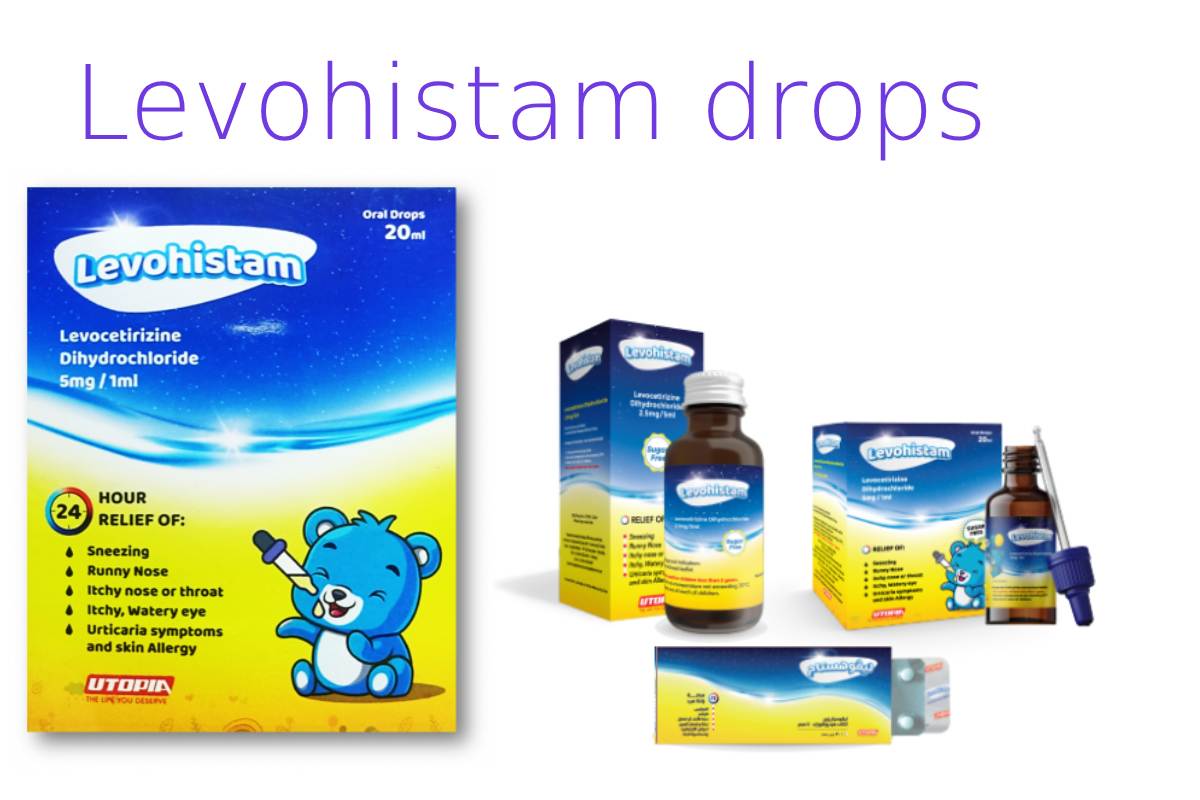Levohistam Drops contain the active ingredient Levocetirizine dihydrochloride (an antihistamine) and are used to treat allergic conditions.
According to the manufacturer details, Levohistam is indicated for:
- Allergic rhinitis (year-round and seasonal) in children from about 2 years of age.
- Chronic idiopathic urticaria (hives) in adults and children from about 2 years of age.
- The drops form (20 ml bottle) is a liquid form suitable especially for children or people who struggle with tablets.
Table of Contents
What is it used for?
The drops are used to relieve symptoms such as:
- Sneezing, runny nose, itchy or watery eyes (from nasal allergies)
- Itchy skin, hives (urticaria), allergic rashes
- Possibly insect bite reactions that manifest as itching or swelling (as part of allergic skin reaction)
- Because levocetirizine works by blocking histamine (a chemical released in allergic response) the symptoms are reduced.
How do you use Levohistam Drops – Dose Guidelines
Here are commonly referenced dose guidelines for the drops/solution form (note: local product may label slightly differently — always check packaging & doctor’s advice).
Adults & children aged 12 years and older:
- 5 mg once daily. The drops form often equates to “20 drops” or similar depending on dropper.
Children aged 6 to 11 years:
- 2.5 mg once daily. For example approx “10 drops” in the product listing.
Children aged 2 to 5 years:
- 1.25 mg once daily. For example approx “5 drops”.
Infants below 2 years:
- Use in children under 2 years: Data is limited and some sources say not enough evidence to support use.
How to administer:
- The drops can be given with or without food.
- In children, the drops can be diluted in a little water if needed (check instructions).
- Important: Do not give more than the daily recommended dose. For children, exceeding recommended dose may increase side-effects.
What should you expect — onset & effect
- The onset of effect for levocetirizine can be within about 1 hour for some allergic rhinitis cases.
- It is typically taken once daily, usually in the evening, since symptoms often worsen or persist overnight.
- For persistent allergies (daily/long-term exposure) it may be taken continuously during exposure to allergens. For intermittent exposure it may be stopped once symptoms disappear.
Side-Effects & Precautions
Common side-effects may include:
- Mild drowsiness or sleepiness (though this antihistamine is less sedating than older types)
- Dry mouth, fatigue, headache.
- For young children: diarrhea, vomiting, or ear infections were noted in some trials.
Precautions:
- If you (or the child) have severe kidney impairment, dose adjustment or not using may be needed.
- If you (or the child) are allergic to levocetirizine, cetirizine or other antihistamines, this medicine should be avoided.
- Avoid mixing with alcohol or other medicines that cause sedation (drowsiness) because effects may add up.
- If you notice trouble emptying the bladder, or urinary retention (especially older men with prostate issues) – consult doctor.
Is Levohistam “sedative”?
While levocetirizine is less likely to cause sedation compared to older antihistamines, yes, some people may feel sleepy or drowsy after taking it.
Because of that:
- Use caution when driving a vehicle or operating machinery until you know how you’re affected.
- In children, if pronounced drowsiness appears, it should be discussed with the doctor.
When not to use / When to be careful
- If known allergy (hypersensitivity) to levocetirizine, cetirizine or any component of the product
- If severe renal disease (creatinine clearance < 10 mL/min) or on dialysis — may be contraindicated.
- Use in infants under 6 months: safety and efficacy are not well established.
- If underlying condition of prostatic hypertrophy (urinary retention) or other bladder/urine problems.
Summary
In short:
Levohistam Drops are a liquid form of levocetirizine used for allergies (runny nose, sneezing, itchy/watery eyes, hives) in children (and adults)
- Doses vary by age: ~1.25 mg for young children (2-5 yrs), ~2.5 mg for 6-11 yrs, ~5 mg for 12 yrs+
- Taken once daily, with or without food
- Side-effects mild for most, but drowsiness can happen
- Not strongly sedative, but caution still required
- Always check with your doctor/pharmacist especially for young child, kidney problems, other medicines
Important Note
This article is informational only. It does not replace medical advice. For your specific case (child, adult, dosage), you must consult your doctor or pharmacist — especially when combining with other medicines, or if underlying illness exists (kidney, liver, pregnancy, etc).

